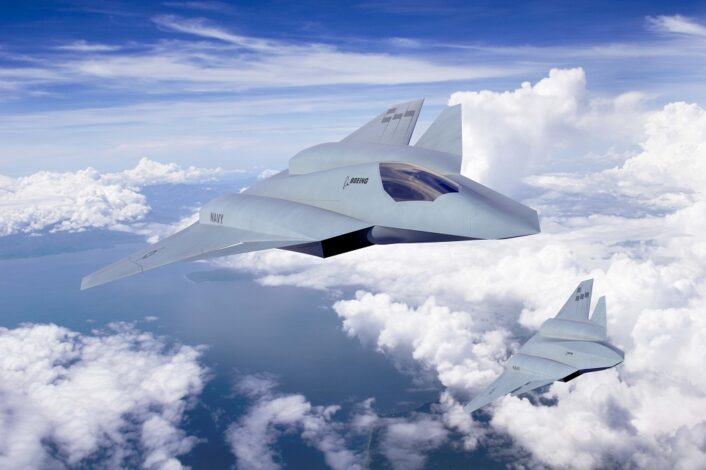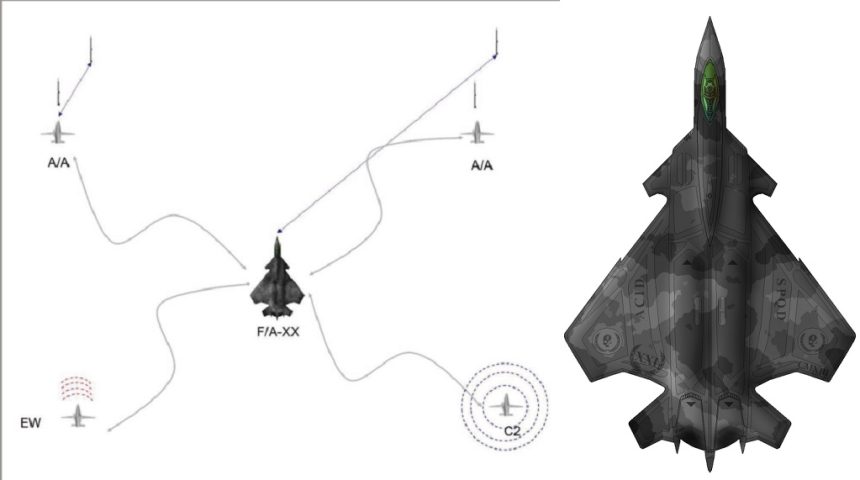The new F/A-XX will replace the F/A-18E/F Super Hornet in the 2030s as the strike fighter component within the Next Generation Air Dominance Family of Systems.
The U.S. Navy published last week the unclassified version of the “Navy Aviation Vision 2030-2035”, which reflects the key concepts that define how Naval Aviation will evolve into the next decade by “updating current capabilities, bringing new and advanced platforms online, and complementing today’s warfighting competency with enhanced tactics and procedures for the high-end fight”. The goal is to have “a Navy that swarms the sea, delivering synchronized lethal and non-lethal efforts from near and far, on every axis and in every domain.”
The document lays out three key elements: delivering capability and capacity to win in the Great Power Competition (GPC); generating future readiness across the force; achieving revolutionary training to form the framework of Navy Aviation’s future. These goals are essential as maritime warfare is rapidly evolving, with China and Russia continuing to work to erode the U.S. Navy’s warfighting advantages, as stated in the document, “developing and employing an increasing number of high-end capabilities at a pace not seen since the height of the Cold War”.
Some of the threats expected by Naval Aviation are the increased People’s Liberation Army Navy (PLAN) aircraft carrier inventory, improved People’s Liberation Army Air Force (PLAAF) capabilities and capacity, advanced kill chains that extend over great distances, proliferation of complex threat emitters, Command, Control, Communications, Computers, Intelligence, Surveillance, Reconnaissance, and Targeting (C4ISR&T) networks and information warfare attacks.
Preparing to face these threats, Navy Aviation is pursuing new advanced technologies, such as Radio Frequency (RF) and Infrared (IR) signature reduction technologies, enhanced passive and active kill chains, Manned/UnManned Teaming (MUM-T), increased speed and range, long-range, high-capacity, and hypersonic weapons, decreased decision-making timelines, Electromagnetic Maneuver Warfare (EMW) capabilities, cyber capabilities, advanced networks and the new Ford Class aircraft carriers.
The Ford Class CVNs are considered “a revolutionary jump in carrier aviation and the future of large-deck, nuclear-powered aircraft carriers designed to fight and win over near-peer adversaries in GPC”, and will “serve as the cornerstone of a lethal, agile, resilient, and readily adaptable distributed maritime force required by the National Defense Strategy”. The revolution of the carrier aviation will obviously bee accompanied by deep changes to the Carrier Air Wing (CVW), which is the primary fighting element of the Carrier Strike Group (CSG).
“The Air Wing of the Future will be increasingly lethal, survivable, networked, sustainable, and unmanned with autonomous capabilities”, reads the document, with platforms able to deny and defeat air and surface-based threats in a coordinated multi-domain environment by employing kinetic and non-kinetic effects, delivering precision effects on any target with next generation aircraft that will have greater range and speed. In fact, the CVW of the 2030s is described as a complementary mix of F-35C Lightning II, F/A-18E/F Block III Super Hornet, and a next generation strike fighter dubbed F/A-XX.
The F/A-XX is the strike fighter component within the Next Generation Air Dominance (NGAD) Family of Systems (FoS). The requirement for this aircraft has been around since 2008, with a formal Request for Information in 2012, to replace the F/A-18E/F Super Hornet in the 2030s. Later, the F/A-XX was included in the NGAD program which, by the way, is a separate program from the identically named Air Force program. The Navy says that its “specific capabilities and technologies are under development, however analysis shows it must have longer range and greater speed, incorporate passive and active sensor technology, and possess the capability to employ the longer-range weapons programmed for the future”.

The NGAD FoS will include unmanned platforms with F/A-XX as the quarterback, exploiting the Manned/UnManned Teaming (MUM-T) concept to reduce risk to the manned aircraft, while simultaneously increasing capability, capacity, and survivability. The new MQ-25 Stingray will be the first unmanned asset to employ this capability, extending the strike range and enhancing maneuverability of the Carrier Air Wing. Continued development of MUM-T will enable information sharing across a distributed force, increasing survivability, reducing risk to manned aircraft, and ensuring weapons capacity.
The Navy envisions future unmanned air vehicles with survivable planforms, sensors, and robust autonomy able to find, fix, identify, track, engage, and assess land, sea, and air targets. These UAVs will be employed alongside manned aircraft and unmanned attritable assets to enable integrated kinetic and non-kinetic fires at tactically relevant ranges in multidomain operations. The Navy is evaluating the appropriate mix of F/A-XX, manned and unmanned platforms to ensure the most lethal and affordable CVW possible, depending also on the maturity of autonomy and Machine Learning technologies.
Together with the description, the document presents a concept art of the F/A-XX showing a lambda wing, canards and “YF-23-style ruddervators”. While some of the features, like the canards, might disrupt the low-observability characteristics, it is worth noting that the design might not reflect any actual aircraft currently being developed. As a matter of fact, we can confirm that the design in question is completely fictional and simply used as a placeholder.
NAVAIR has released new concept art of the F/A-XX, showing canards, a pseudo lambda/delta wing, and, I think, YF-23-style ruddervators (but they might be stabilizers.) The description also calls for more speed and range than F/A-18E/F Block III. https://t.co/ztebX38Mqo pic.twitter.com/c2LAlGqQSZ
— Steve Trimble (@TheDEWLine) October 29, 2021
Even if the Navy used a very low-resolution image, we were able to trace it back to the original design, which was found in a public forum on the popular website Tapatalk. The design, dubbed the TF-70 “Shukusei” Seventh Generation Advanced Air Superiority Fighter, is a completely fictional aircraft accompanied by a lengthy description possibly inspired by current fighter aircraft and the world from the “Ace Combat” videogames. Its author described the aircraft saying that it “utilizes dogtoothed mission adaptive wings paired with canards and flat ruddervators aft of the fighter”.
Anyway, even if we couldn’t find the original design used by the Navy, it would have been highly unlikely for a real sixth generation aircraft design to appear on an unclassified document. As you may recall, the Air Force already flew its prototype for a similar aircraft and, after more than a year from the announcement, there aren’t any unclassified images of its design, so neither service is taking risks by showing to the world their newest fighter aircraft.
The image shared by the Navy also shows the F/A-XX operating in a MUM-T environment with four drones, whose shape represents the MQ-25. Interestingly, the drones are shown employing Air-to-Air (AA), Electronic Warfare (EW) and Command and Control (C2) payloads, much like the Loyal Wingman drones currently being developed. This falls in line with the service envisioning Unmanned Air Systems (UAS) to fill refueling, communications relay, logistics, airborne electronic attack, strike, and ISR&T missions in the future air wing.
Back to the CVW, the Navy says that, as the Super Hornets are retired from service, a combination of F-35C and F/A-XX will provide the tactical fighter aircraft capability and capacity within the Navy Aviation. The F-35C Block IV is considered as an invaluable force multiplier for the CSG in 2030 and beyond. Its stealth and passive detection capabilities will aid the kill chain with the gathering of critical intelligence, as well as making it the Navy’s strike platform of choice with the Joint Standoff Weapon (JSOW) C1, Advanced Anti-Radiation Guided Missile Extended Range (AARGM ER) and Small Diameter Bomb (SDB) II that are being integrated.
The F-35C will also allow the F/A-18E/F Block III to be a more survivable and lethal platform by leveraging the stealth and passive detection abilities to shape the overall air picture, while the emerging Electronic Warfare (EW) capabilities will complement and augment the EA-18G Growler. The EA-18G Airborne Electronic Attack (AEA) will continue to provide full-spectrum integrated non-kinetic effects for the air wing thanks to the new Next Generation Jammer (NGJ) and other Non-Kinetic Effects (NKE).









